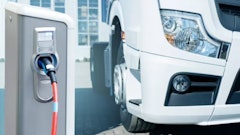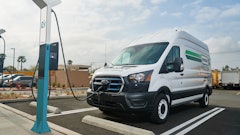
Commercial electric vehicles (EVs) are poised to transform supply chain management, fueled by shipper sustainability goals, technological vehicle advancements and regulatory pressures. This transformation creates a new opportunity for competitive advantage for early adopter carriers and a new frontier for shipper-carrier partnerships.
Corporate Sustainability Goals: Leading the Charge
Shippers are setting ambitious emission reduction goals and looking to their carriers and supply chain partners to help meet them. Initiatives to reduce greenhouse gas (GHG) emissions in the supply chain like Walmart's Project Gigaton and IKEA's commitment to expand zero-emission deliveries have taken off in recent years. Once established, ambitious initiatives led by some of the world’s largest shippers have the potential to transform the logistics industry.
As more companies set aggressive GHG reduction targets, up from just 1% of S&P companies in 2016 to 42% in 2022, shippers are examining their supply chains for deeper emission cuts. The ability to provide zero-emission transportation and logistics services, and therefore enable shippers to make progress towards their own goals, is becoming a new frontier for differentiation and carrier competitive advantage.
As the logistics and transportation sectors pivot towards cleaner technologies, it’s not sufficient to simply adopt new technologies and expect to gain a competitive edge. Major shippers require credible, verifiable accounting of GHG emissions using globally accepted accounting methods such as the GHG Protocol and the GLEC Framework, specifically adapted for logistics. It’s also critical to remember that deploying a handful of EVs may only provide negligible emissions reductions. Real strategic value comes from developing a sustainability roadmap that includes technology evaluation and multi-year adoption, goal setting and GHG emissions accounting and formal reporting which can then be translated into measurable progress for shippers.
Technological Advancements in EVs Fueling Growth
The past decade has seen rapid investments in electric vehicle manufacturing in the U.S. Nearly all medium- and heavy-duty truck manufacturers are now bringing zero-emission vehicles to market, with several manufacturers committing to transitioning their entire product portfolios to electric vehicles.
More than $120 billion in investments and a resulting 143,000 new U.S. jobs have been announced in the past eight years, with more than 40% of those announcements happening in the past 18 months alone.
Specifically for short-haul distribution, local delivery, port drayage and warehouse operations, battery-electric trucks, vans, forklifts, and yard tractors are proving an operational best-fit and establishing a foothold in the sector with thousands of battery-electric units now deployed and in operation.
The Policy Push: Accelerating EV Adoption
The landscape for commercial zero-emission vehicles (ZEVs) in North America is also being shaped by policies at the local, state, and federal level. A collective of 11 states have positioned themselves as ZEV leaders by adopting the Advanced Clean Truck (ACT) Rule which imposes a ZEV sales mandate for large truck makers. This is paired with California’s Advanced Clean Fleets (ACF) Rule, which targets vehicle demand rather than supply by requiring certain fleets to purchase or deploy an increasing number of ZEVs with a goal of reaching zero-emissions state-wide by 2045.
In parts of Southern California, the Warehouse Actions and Investments to Reduce Emissions (WAIRE) program is aiming to mitigate emissions produced by heavy- and medium-duty trucks that service one of the nation’s largest warehouse markets. This program translates warehouse truck trips into a point system that can result in significant financial obligations for the warehouse owner or operator, potentially hundreds of thousands of dollars annually in fees, unless the warehouse owner invests in clean technologies and infrastructure to offset their points.
Meanwhile, stricter emissions standards, such as the EPA Clean Trucks Rule for model year 2027 and beyond will effectively make diesel engine technology more expensive to operate and more complex to maintain. One result of these regulations is that the cost and performance gap between incumbent diesel technology and new zero-emission electric vehicles may diminish.
Navigating Changes with Shipper-Carrier Education & Partnerships
This constantly evolving landscape of clean vehicle technology means that supply chain professionals will have to learn a complex new set of skills to evaluate technologies and compare GHG emissions alongside existing business-critical metrics such as cost and performance.
Meanwhile, EV adoption in supply chain management is fostering new expectations for shipper-carrier collaboration. Educational initiatives play an important role in this transition, convening top shippers with their logistics partners to clarify goals, expectations and explore sustainable solutions collaboratively.
Redefining the Future of Supply Chains
The integration of electric vehicles into supply chain operations demands new practices and a deeper understanding of the technology's strengths and limitations. Material handling equipment and drayage operations may prove to be a strong fit for electric vehicles and an easy entry point to begin adoption whereas long-haul vehicles still require numerous advancements.
As shippers and carriers navigate this transformation, the successful adoption of EVs – and measuring the progress they generate toward GHG goals – will increasingly become a marker of operational excellence and efficiency. The future of supply chain management lies in embracing these changes, initiating new collaboration and partnership and leveraging innovation to build a sustainable, efficient logistics landscape.

























